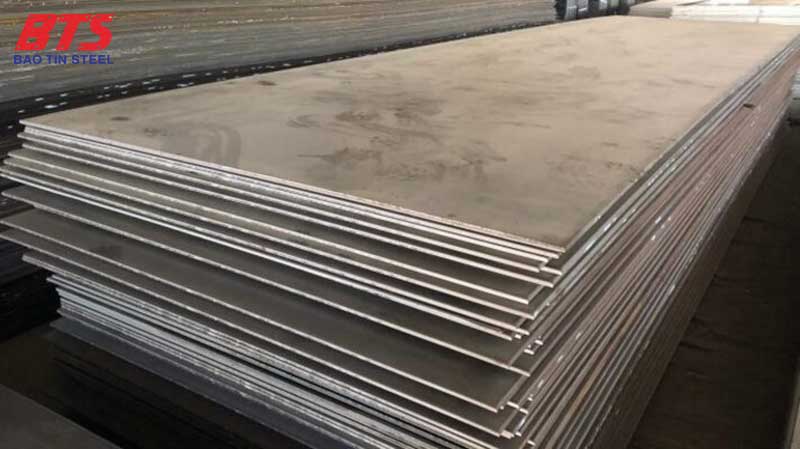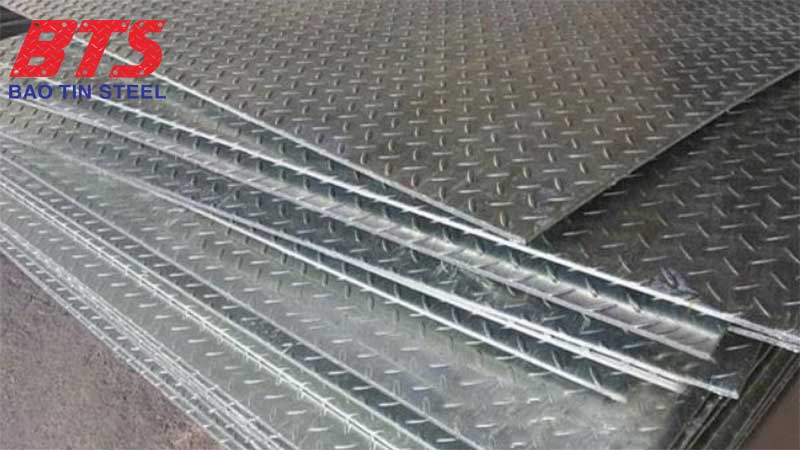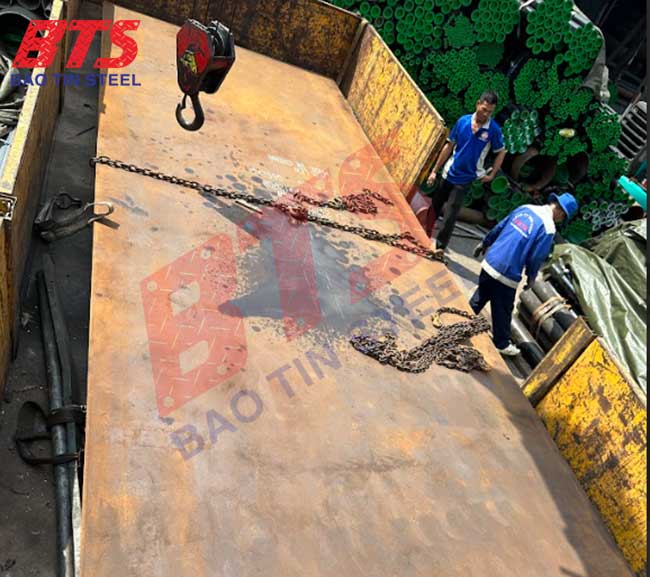Knowing how to calculate the volume of steel plates helps construction workers calculate and understand the calculation formula, which is extremely useful if there are no available weight tableware steel sheets suitable for the project. Understanding the calculation formula is extremely useful if there is no available weight table. If you don’t know about that formula, see the article below!
Types of steel plates on the market
To meet users’ needs, many types of steel plates have been created. Depending on the structure, people divided steel plates into the following types:
Plain steel plate

This type of steel has high hardness, durability, and good bearing capacity but is susceptible to corrosion and rust. Therefore, before being put into use, people often paint or galvanize the outside of the steel plate. This helps prolong its lifespan.
This steel plate has a smooth surface and is easy to process, cut, and weld. However, the correct techniques must be followed so that the processing does not affect the durability of the steel. There are two common types of plain steel plates, including carbon steel plates and alloy steel plates. Depending on the project, we can choose the appropriate type of steel plate.
Checker steel plate
Checker steel plates have a ribbed surface using different methods such as rolling, stamping, pressing, etc. These ribs have different shapes such as square, diamond, or rectangular.
These ribs on the steel surface help create friction, increasing adhesion between the steel surface and other objects. This prevents slipping. This is also the reason why this type of steel plate is used for applications that require safety. For example: factory floors, stairs, walkways,…

In addition to being anti-slip, thanks to its special structure, this steel is also very resistant to impact. When impacted, it is less deformed. Thanks to that, this steel is often used as a protective shield, anti-impact, etc. Additionally, by being plated with a layer of zinc on the outside, the ribbed iron sheet rusts less and is durable even in harsh weather conditions.
Round steel plate
As its name suggests, this type of steel plate has a round shape and uniform thickness. At the same time, it is also made by the hot rolling or cold rolling method.
Round steel plates possess all the outstanding characteristics of regular steel plates. These include durability, load-bearing capacity, force resistance, abrasion resistance, and good corrosion resistance. This is why it is widely used in applications exposed to chemicals or harsh weather conditions.

>> See more about the steel plate Processing Process to better understand this steel line.
A simple way to calculate steel plate volume
Many people think that as long as there is a table to look up the weight of the steel plate, there is no need to worry about anything. However, in the absence of these available data, understanding the calculation formula is extremely necessary.
Knowing how to calculate the volume of steel plate helps you buy the right steel for your project. From there, ensure the safety of the project as well as its longevity. Below are common formulas for calculating the number of steel plates:
Formula to calculate the weight of plain steel plate
Steel plate weight (kg) = Thickness (mm) x Width (meters) x Length (meters) x 7.85 (g/cm3).
For example: How to calculate the weight (volume) of a 10mm x 1500mm x 6000mm steel plate as follows:
To apply the above formula, we convert the length and width dimensions from mm (millimeters) to m (meters):
- 1500mm = 1.5 meters
- 6000mm = 6 meters
=> Weight of a 10mm steel plate = (7.85 x 1.5 x 6 x 10) = 706.5 kg.
Formula to calculate the weight of the checker steel plate
Kg = [7.85 x Length (meters) x Width (meters) x Thickness (mm)] + [3 x Width (meters) x Length (meters)].
For example: How to calculate the weight (volume) of a 6mm x 1500 x 6000 ribbed steel plate as follows:
We also perform mm -> m rotation
- 1500mm = 1.5 meters
- 6000mm = 6 meters
=> Weight of a 6mm checker steel plate = (7.85 x 6 x 1.5 x 6) + (3 x 1.5 x 6) = 450.9 kg.
The formula for calculating the weight of round steel plates
Round plate weight (kg) = 6.25 x Diameter (m) x Diameter (m) x Thickness (mm)
For example, calculate the weight of a round plate 550mm diameter x 25mm thick:
We convert the diameter size from mm -> m. We have:
- 550mm = 0.550 meters
Weight of round plate 550mm x 25mm = 6.25 x 0.550 x 0.550 x 25 = 47.2656 kg
It can be seen that calculating the volume of steel plate is not too complicated. Therefore, please write down these useful formulas to apply them effectively at work!
Where to buy quality steel plates?
Knowing how to calculate the volume of steel plate, you need to choose to buy products that meet the calculated data. Because only such products can ensure the quality of the project as well as safety.

Are you looking for a supplier of quality steel plates at good prices? Find out now about Bao Tin Steel, the address for importing and distributing quality iron and steel.
Bao Tin Steel Co., Ltd. has more than 10 years of operation in this industry. The products are not only steel plates but also steel pipes, square steel tubes, and shaped steel H, I, U, V, C, and Z are all genuine. Our main partners are all big brands such as Hoa Phat, Hoa Sen, Viet Duc, VinaOne, and Nam Kim,…
Customers of products at Bao Tin Steel will be committed to:
- 100% new product, fully sourced and certified
- Competitive prices, without going through any intermediaries
- Full invoice and VAT
In particular, customers can come to the Bao Tin Steel warehouse to view goods and make a deposit.
Above is how to calculate the volume of the steel plate. Bao Tin Steel hopes this information will be really useful to everyone. If you have any questions or need assistance, call Hotline immediately: 0932 059 176.


 Tiếng Việt
Tiếng Việt ភាសាខ្មែរ
ភាសាខ្មែរ